1997 SSANGYONG KORANDO battery
[x] Cancel search: batteryPage 1134 of 2053
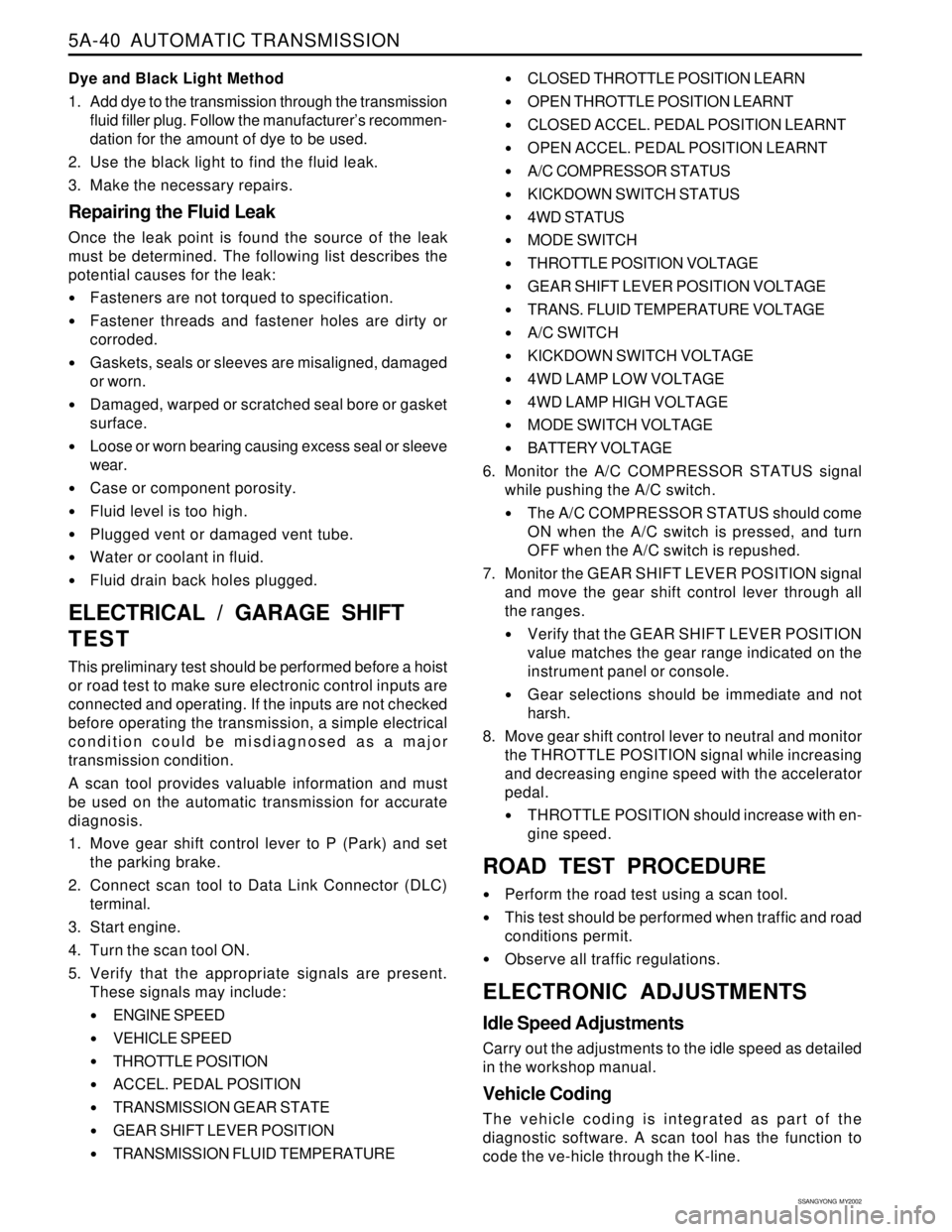
5A-40 AUTOMATIC TRANSMISSION
SSANGYONG MY2002
Dye and Black Light Method
1. Add dye to the transmission through the transmission
fluid filler plug. Follow the manufacturer’s recommen-
dation for the amount of dye to be used.
2. Use the black light to find the fluid leak.
3. Make the necessary repairs.
Repairing the Fluid Leak
Once the leak point is found the source of the leak
must be determined. The following list describes the
potential causes for the leak:
Fasteners are not torqued to specification.
Fastener threads and fastener holes are dirty or
corroded.
Gaskets, seals or sleeves are misaligned, damaged
or worn.
Damaged, warped or scratched seal bore or gasket
surface.
Loose or worn bearing causing excess seal or sleeve
wear.
Case or component porosity.
Fluid level is too high.
Plugged vent or damaged vent tube.
Water or coolant in fluid.
Fluid drain back holes plugged.
ELECTRICAL / GARAGE SHIFT
TEST
This preliminary test should be performed before a hoist
or road test to make sure electronic control inputs are
connected and operating. If the inputs are not checked
before operating the transmission, a simple electrical
condition could be misdiagnosed as a major
transmission condition.
A scan tool provides valuable information and must
be used on the automatic transmission for accurate
diagnosis.
1. Move gear shift control lever to P (Park) and set
the parking brake.
2. Connect scan tool to Data Link Connector (DLC)
terminal.
3. Start engine.
4. Turn the scan tool ON.
5. Verify that the appropriate signals are present.
These signals may include:
ENGINE SPEED
VEHICLE SPEED
THROTTLE POSITION
ACCEL. PEDAL POSITION
TRANSMISSION GEAR STATE
GEAR SHIFT LEVER POSITION
TRANSMISSION FLUID TEMPERATURE
CLOSED THROTTLE POSITION LEARN
OPEN THROTTLE POSITION LEARNT
CLOSED ACCEL. PEDAL POSITION LEARNT
OPEN ACCEL. PEDAL POSITION LEARNT
A/C COMPRESSOR STATUS
KICKDOWN SWITCH STATUS
4WD STATUS
MODE SWITCH
THROTTLE POSITION VOLTAGE
GEAR SHIFT LEVER POSITION VOLTAGE
TRANS. FLUID TEMPERATURE VOLTAGE
A/C SWITCH
KICKDOWN SWITCH VOLTAGE
4WD LAMP LOW VOLTAGE
4WD LAMP HIGH VOLTAGE
MODE SWITCH VOLTAGE
BATTERY VOLTAGE
6. Monitor the A/C COMPRESSOR STATUS signal
while pushing the A/C switch.
The A/C COMPRESSOR STATUS should come
ON when the A/C switch is pressed, and turn
OFF when the A/C switch is repushed.
7. Monitor the GEAR SHIFT LEVER POSITION signal
and move the gear shift control lever through all
the ranges.
Verify that the GEAR SHIFT LEVER POSITION
value matches the gear range indicated on the
instrument panel or console.
Gear selections should be immediate and not
harsh.
8. Move gear shift control lever to neutral and monitor
the THROTTLE POSITION signal while increasing
and decreasing engine speed with the accelerator
pedal.
THROTTLE POSITION should increase with en-
gine speed.
ROAD TEST PROCEDURE
Perform the road test using a scan tool.
This test should be performed when traffic and road
conditions permit.
Observe all traffic regulations.
ELECTRONIC ADJUSTMENTS
Idle Speed Adjustments
Carry out the adjustments to the idle speed as detailed
in the workshop manual.
Vehicle Coding
The vehicle coding is integrated as part of the
diagnostic software. A scan tool has the function to
code the ve-hicle through the K-line.
Page 1135 of 2053
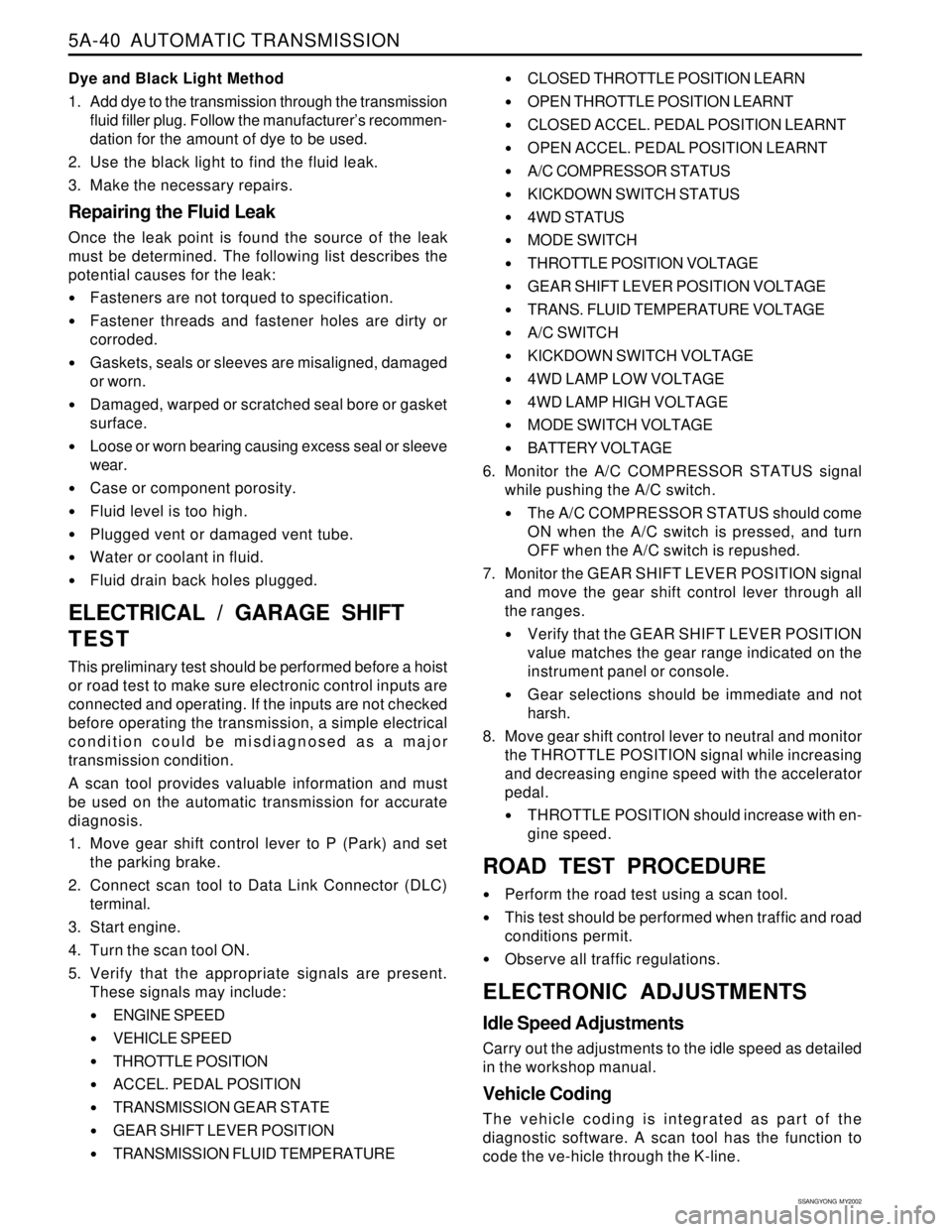
5A-40 AUTOMATIC TRANSMISSION
SSANGYONG MY2002
Dye and Black Light Method
1. Add dye to the transmission through the transmission
fluid filler plug. Follow the manufacturer’s recommen-
dation for the amount of dye to be used.
2. Use the black light to find the fluid leak.
3. Make the necessary repairs.
Repairing the Fluid Leak
Once the leak point is found the source of the leak
must be determined. The following list describes the
potential causes for the leak:
Fasteners are not torqued to specification.
Fastener threads and fastener holes are dirty or
corroded.
Gaskets, seals or sleeves are misaligned, damaged
or worn.
Damaged, warped or scratched seal bore or gasket
surface.
Loose or worn bearing causing excess seal or sleeve
wear.
Case or component porosity.
Fluid level is too high.
Plugged vent or damaged vent tube.
Water or coolant in fluid.
Fluid drain back holes plugged.
ELECTRICAL / GARAGE SHIFT
TEST
This preliminary test should be performed before a hoist
or road test to make sure electronic control inputs are
connected and operating. If the inputs are not checked
before operating the transmission, a simple electrical
condition could be misdiagnosed as a major
transmission condition.
A scan tool provides valuable information and must
be used on the automatic transmission for accurate
diagnosis.
1. Move gear shift control lever to P (Park) and set
the parking brake.
2. Connect scan tool to Data Link Connector (DLC)
terminal.
3. Start engine.
4. Turn the scan tool ON.
5. Verify that the appropriate signals are present.
These signals may include:
ENGINE SPEED
VEHICLE SPEED
THROTTLE POSITION
ACCEL. PEDAL POSITION
TRANSMISSION GEAR STATE
GEAR SHIFT LEVER POSITION
TRANSMISSION FLUID TEMPERATURE
CLOSED THROTTLE POSITION LEARN
OPEN THROTTLE POSITION LEARNT
CLOSED ACCEL. PEDAL POSITION LEARNT
OPEN ACCEL. PEDAL POSITION LEARNT
A/C COMPRESSOR STATUS
KICKDOWN SWITCH STATUS
4WD STATUS
MODE SWITCH
THROTTLE POSITION VOLTAGE
GEAR SHIFT LEVER POSITION VOLTAGE
TRANS. FLUID TEMPERATURE VOLTAGE
A/C SWITCH
KICKDOWN SWITCH VOLTAGE
4WD LAMP LOW VOLTAGE
4WD LAMP HIGH VOLTAGE
MODE SWITCH VOLTAGE
BATTERY VOLTAGE
6. Monitor the A/C COMPRESSOR STATUS signal
while pushing the A/C switch.
The A/C COMPRESSOR STATUS should come
ON when the A/C switch is pressed, and turn
OFF when the A/C switch is repushed.
7. Monitor the GEAR SHIFT LEVER POSITION signal
and move the gear shift control lever through all
the ranges.
Verify that the GEAR SHIFT LEVER POSITION
value matches the gear range indicated on the
instrument panel or console.
Gear selections should be immediate and not
harsh.
8. Move gear shift control lever to neutral and monitor
the THROTTLE POSITION signal while increasing
and decreasing engine speed with the accelerator
pedal.
THROTTLE POSITION should increase with en-
gine speed.
ROAD TEST PROCEDURE
Perform the road test using a scan tool.
This test should be performed when traffic and road
conditions permit.
Observe all traffic regulations.
ELECTRONIC ADJUSTMENTS
Idle Speed Adjustments
Carry out the adjustments to the idle speed as detailed
in the workshop manual.
Vehicle Coding
The vehicle coding is integrated as part of the
diagnostic software. A scan tool has the function to
code the ve-hicle through the K-line.
Page 1169 of 2053

5A-74 AUTOMATIC TRANSMISSION
SSANGYONG MY2002
Circuit Description
The battery voltage monitoring input is connected to
the positive side of the battery. This signal is taken
from the main supply to the TCM.
If the battery voltage at the TCM falls below the thresh-
old value, DTC P1708 will be set and the transmission
will adopt a low voltage mode of operating in which
shifts into first gear are inhibited. All other shifts are
attempted but may not occur because of the reduced
voltage. This condition normally occurs only when the
battery is in poor condition.
When system voltage recovers, the TCM will resume
normal operation after a 30 seconds delay period.
Conditions for Setting the DTC
The engine speed is greater than 550 RPM.
A driving gear is selected or one of DTCs P0706,
P0707 and P0708 is set.
The indicated supply voltage falls below a linear
temperature characteristic threshold or below that
required to operate the CPU. If the TCM measures
the supply voltage at less than that required for it
to be operating, the DTC sets immediately.
Action Taken When the DTC Sets
1st gear is inhibited.
S6 is inhibited.
S5 standby current is zero.
DIAGNOSTIC TROUBLE CODE (DTC) P1708
TCM SUPPLY VOLTAGE LOW
Conditions for Clearing the DTC
The DTC will clear when the malfunction has not
occurred for 30 seconds.
A history DTC will clear after 40 TCM power-up
cycles with a warm transmission (>50 °C) and
without a fault.
History DTCs can be cleared by using a scan tool.
Diagnostic Aids
The minimum operating voltage depends on the
transmission temperature but is typically between
8 - 9 V for a warm transmission.
If the DTC sets when an accessory is operated,
check for a poor connection.
Look for possible bent, backed out, deformed or
damaged terminals. Check for weak terminal tension
as well. Also, check for chafed wires that could short
to bare metal or other wiring. Inspect for broken
wires inside the insulation.
If diagnosing for a possible intermittent short or
open condition, move or massage the wiring harness
while observing test equipment for a change.
Test Description
The number(s) below refer to the step number(s) on
the Diagnostic Table.
4. Check if the generator is malfunctioning under load
condition.
8. Check the ignition feed circuit for excessive resist-
ance.
KAA5A5KA
Page 1170 of 2053
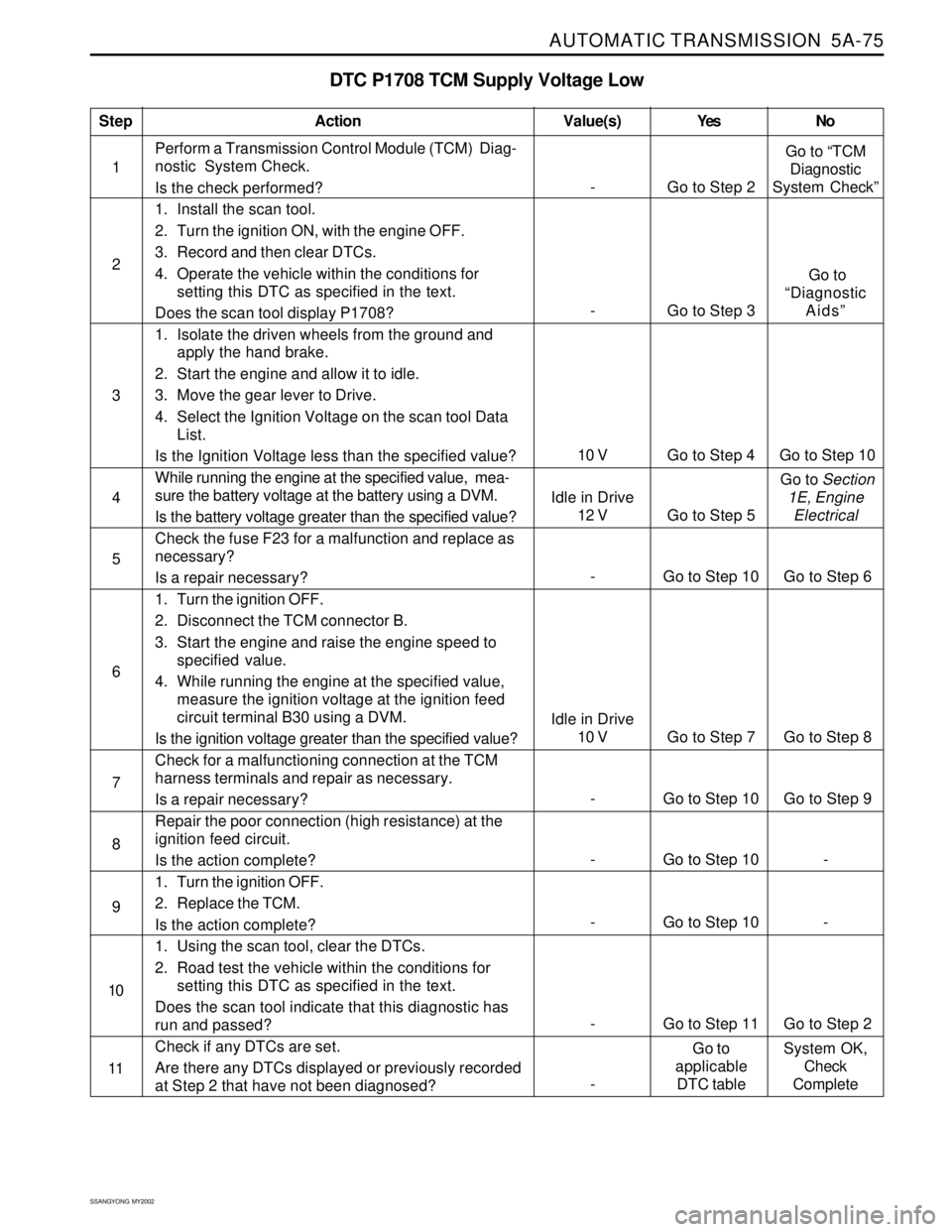
AUTOMATIC TRANSMISSION 5A-75
SSANGYONG MY2002
DTC P1708 TCM Supply Voltage Low
1Perform a Transmission Control Module (TCM) Diag-
nostic System Check.
Is the check performed?
1. Install the scan tool.
2. Turn the ignition ON, with the engine OFF.
3. Record and then clear DTCs.
4. Operate the vehicle within the conditions for
setting this DTC as specified in the text.
Does the scan tool display P1708?
1. Isolate the driven wheels from the ground and
apply the hand brake.
2. Start the engine and allow it to idle.
3. Move the gear lever to Drive.
4. Select the Ignition Voltage on the scan tool Data
List.
Is the Ignition Voltage less than the specified value?
While running the engine at the specified value, mea-
sure the battery voltage at the battery using a DVM.
Is the battery voltage greater than the specified value?
Check the fuse F23 for a malfunction and replace as
necessary?
Is a repair necessary?
1. Turn the ignition OFF.
2. Disconnect the TCM connector B.
3. Start the engine and raise the engine speed to
specified value.
4. While running the engine at the specified value,
measure the ignition voltage at the ignition feed
circuit terminal B30 using a DVM.
Is the ignition voltage greater than the specified value?
Check for a malfunctioning connection at the TCM
harness terminals and repair as necessary.
Is a repair necessary?
Repair the poor connection (high resistance) at the
ignition feed circuit.
Is the action complete?
1. Turn the ignition OFF.
2. Replace the TCM.
Is the action complete?
1. Using the scan tool, clear the DTCs.
2. Road test the vehicle within the conditions for
setting this DTC as specified in the text.
Does the scan tool indicate that this diagnostic has
run and passed?
Check if any DTCs are set.
Are there any DTCs displayed or previously recorded
at Step 2 that have not been diagnosed?
StepAction Value(s) Yes No
2
3
5
- Go to Step 10 Go to Step 9 6 4
- Go to Step 10 - 7
- Go to Step 10 - 8
- Go to Step 11 Go to Step 2 9
10
- Go to Step 2Go to “TCM
Diagnostic
System Check”
10 V Go to Step 4 Go to Step 10
- Go to Step 3 Go to
“Diagnostic
Aids”
11
-Go to
applicable
DTC tableSystem OK,
Check
Complete
- Go to Step 10 Go to Step 6
Idle in Drive
10 V Go to Step 7 Go to Step 8
Idle in Drive
12 V Go to Step 5 Go to Section
1E, Engine
Electrical
Page 1171 of 2053
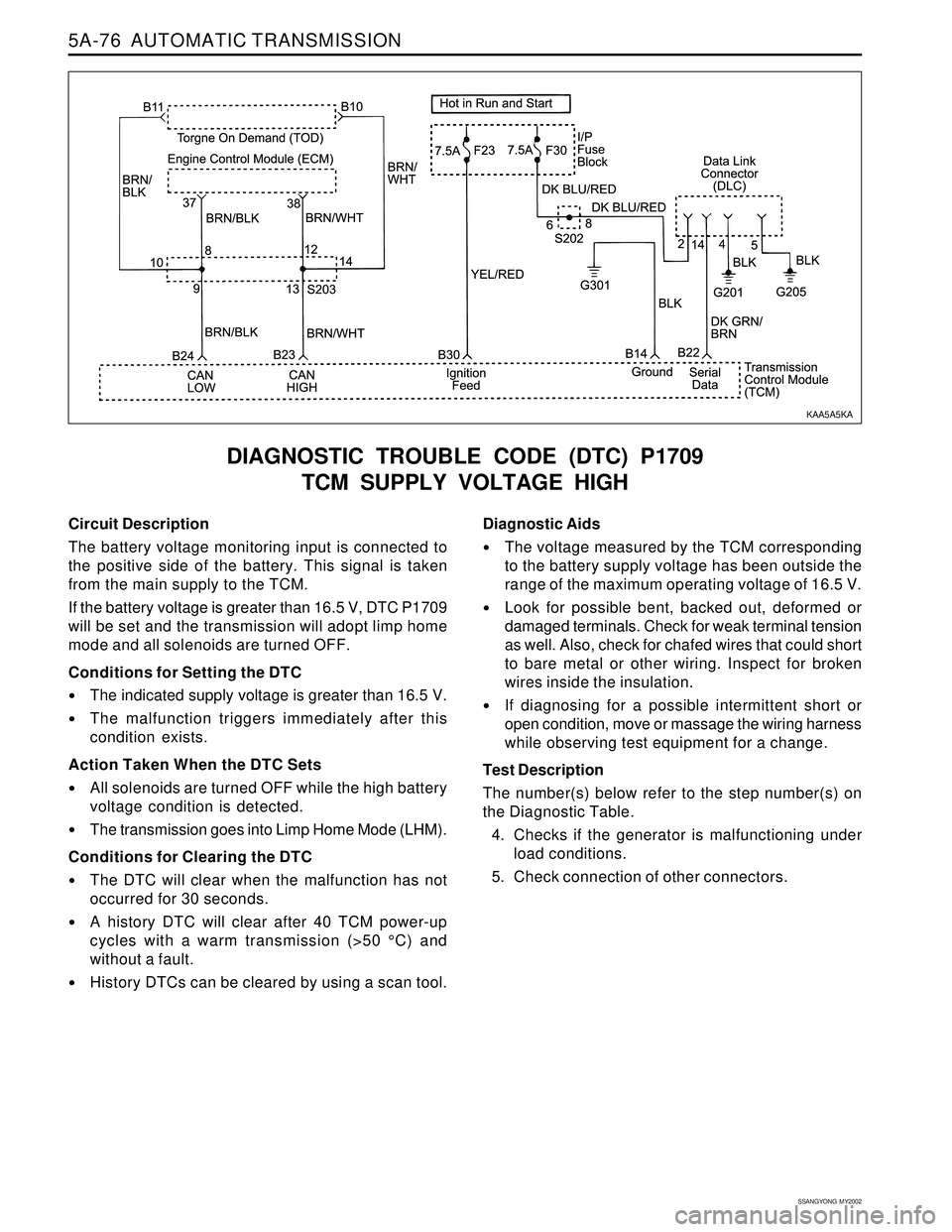
5A-76 AUTOMATIC TRANSMISSION
SSANGYONG MY2002
Circuit Description
The battery voltage monitoring input is connected to
the positive side of the battery. This signal is taken
from the main supply to the TCM.
If the battery voltage is greater than 16.5 V, DTC P1709
will be set and the transmission will adopt limp home
mode and all solenoids are turned OFF.
Conditions for Setting the DTC
The indicated supply voltage is greater than 16.5 V.
The malfunction triggers immediately after this
condition exists.
Action Taken When the DTC Sets
All solenoids are turned OFF while the high battery
voltage condition is detected.
The transmission goes into Limp Home Mode (LHM).
Conditions for Clearing the DTC
The DTC will clear when the malfunction has not
occurred for 30 seconds.
A history DTC will clear after 40 TCM power-up
cycles with a warm transmission (>50 °C) and
without a fault.
History DTCs can be cleared by using a scan tool.
DIAGNOSTIC TROUBLE CODE (DTC) P1709
TCM SUPPLY VOLTAGE HIGH
Diagnostic Aids
The voltage measured by the TCM corresponding
to the battery supply voltage has been outside the
range of the maximum operating voltage of 16.5 V.
Look for possible bent, backed out, deformed or
damaged terminals. Check for weak terminal tension
as well. Also, check for chafed wires that could short
to bare metal or other wiring. Inspect for broken
wires inside the insulation.
If diagnosing for a possible intermittent short or
open condition, move or massage the wiring harness
while observing test equipment for a change.
Test Description
The number(s) below refer to the step number(s) on
the Diagnostic Table.
4. Checks if the generator is malfunctioning under
load conditions.
5. Check connection of other connectors.
KAA5A5KA
Page 1172 of 2053
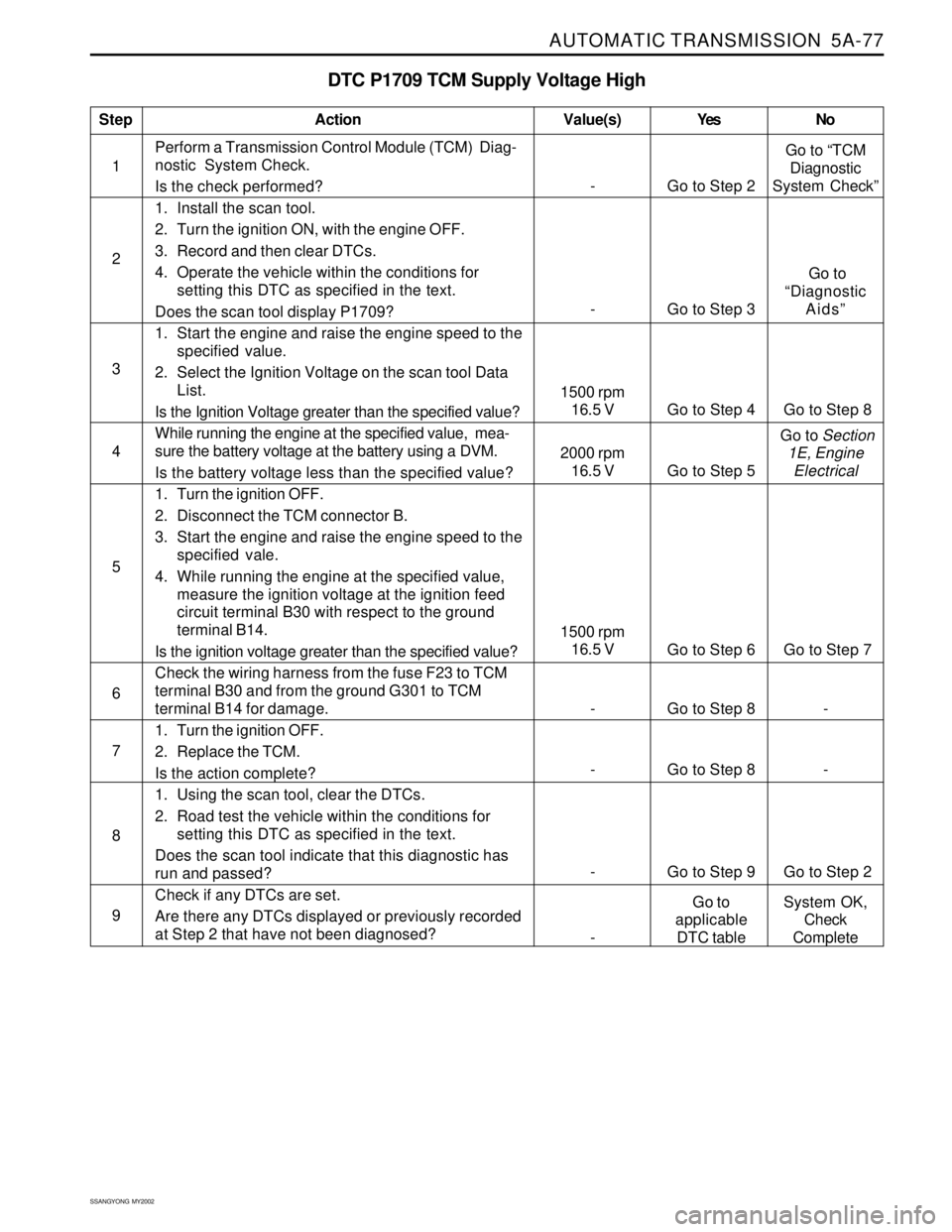
AUTOMATIC TRANSMISSION 5A-77
SSANGYONG MY2002
DTC P1709 TCM Supply Voltage High
1Perform a Transmission Control Module (TCM) Diag-
nostic System Check.
Is the check performed?
1. Install the scan tool.
2. Turn the ignition ON, with the engine OFF.
3. Record and then clear DTCs.
4. Operate the vehicle within the conditions for
setting this DTC as specified in the text.
Does the scan tool display P1709?
1. Start the engine and raise the engine speed to the
specified value.
2. Select the Ignition Voltage on the scan tool Data
List.
Is the Ignition Voltage greater than the specified value?
While running the engine at the specified value, mea-
sure the battery voltage at the battery using a DVM.
Is the battery voltage less than the specified value?
1. Turn the ignition OFF.
2. Disconnect the TCM connector B.
3. Start the engine and raise the engine speed to the
specified vale.
4. While running the engine at the specified value,
measure the ignition voltage at the ignition feed
circuit terminal B30 with respect to the ground
terminal B14.
Is the ignition voltage greater than the specified value?
Check the wiring harness from the fuse F23 to TCM
terminal B30 and from the ground G301 to TCM
terminal B14 for damage.
1. Turn the ignition OFF.
2. Replace the TCM.
Is the action complete?
1. Using the scan tool, clear the DTCs.
2. Road test the vehicle within the conditions for
setting this DTC as specified in the text.
Does the scan tool indicate that this diagnostic has
run and passed?
Check if any DTCs are set.
Are there any DTCs displayed or previously recorded
at Step 2 that have not been diagnosed?
StepAction Value(s) Yes No
2
3
5
6 4
- Go to Step 8 -
7
- Go to Step 8 -
8
- Go to Step 9 Go to Step 2
9
- Go to Step 2Go to “TCM
Diagnostic
System Check”
- Go to Step 3 Go to
“Diagnostic
Aids”
1500 rpm
16.5 V
Go to Step 6 Go to Step 7
1500 rpm
16.5 V Go to Step 4 Go to Step 8
2000 rpm
16.5 V Go to Step 5 Go to Section
1E, Engine
Electrical
-Go to
applicable
DTC tableSystem OK,
Check
Complete
Page 1197 of 2053
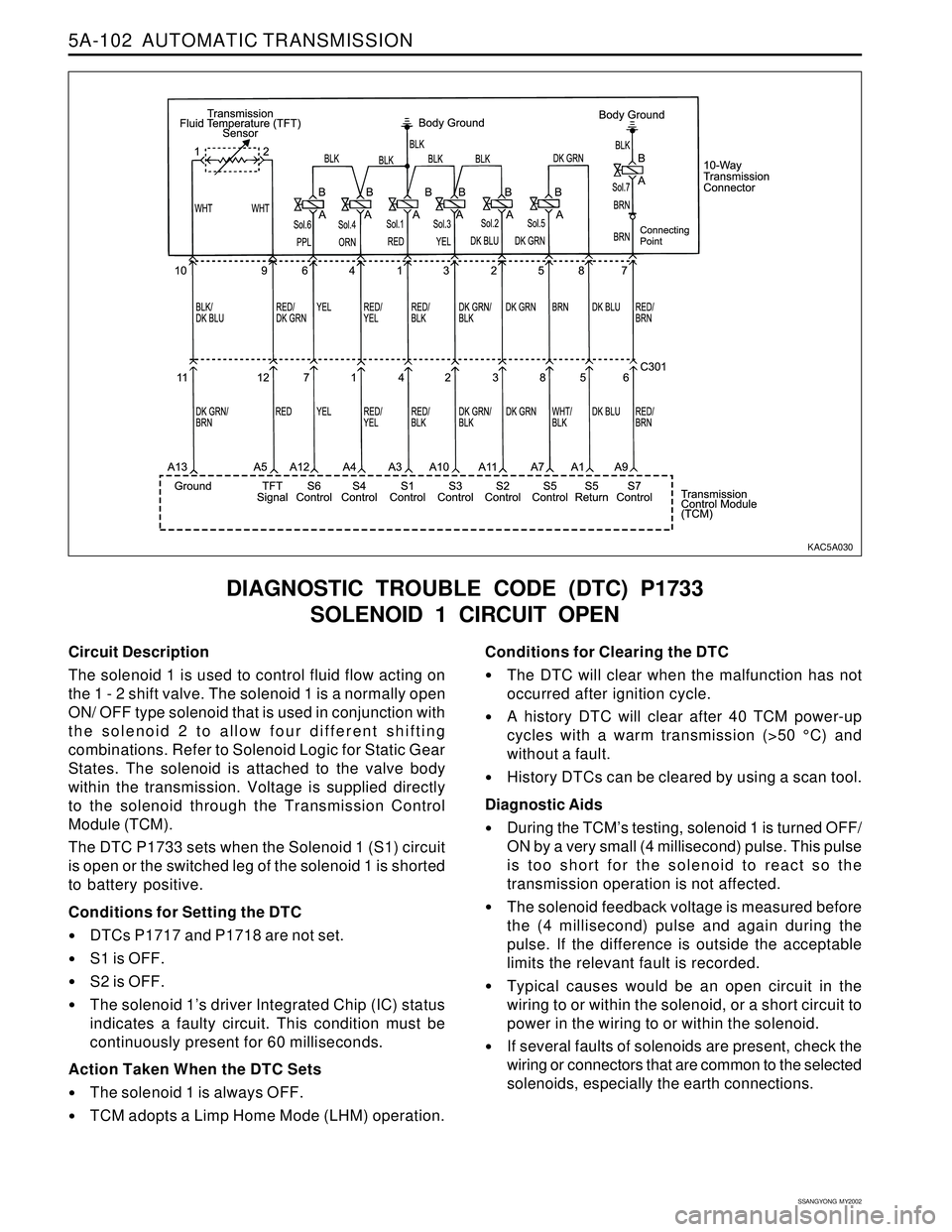
5A-102 AUTOMATIC TRANSMISSION
SSANGYONG MY2002
Circuit Description
The solenoid 1 is used to control fluid flow acting on
the 1 - 2 shift valve. The solenoid 1 is a normally open
ON/ OFF type solenoid that is used in conjunction with
the solenoid 2 to allow four different shifting
combinations. Refer to Solenoid Logic for Static Gear
States. The solenoid is attached to the valve body
within the transmission. Voltage is supplied directly
to the solenoid through the Transmission Control
Module (TCM).
The DTC P1733 sets when the Solenoid 1 (S1) circuit
is open or the switched leg of the solenoid 1 is shorted
to battery positive.
Conditions for Setting the DTC
DTCs P1717 and P1718 are not set.
S1 is OFF.
S2 is OFF.
The solenoid 1’s driver Integrated Chip (IC) status
indicates a faulty circuit. This condition must be
continuously present for 60 milliseconds.
Action Taken When the DTC Sets
The solenoid 1 is always OFF.
TCM adopts a Limp Home Mode (LHM) operation.
DIAGNOSTIC TROUBLE CODE (DTC) P1733
SOLENOID 1 CIRCUIT OPEN
Conditions for Clearing the DTC
The DTC will clear when the malfunction has not
occurred after ignition cycle.
A history DTC will clear after 40 TCM power-up
cycles with a warm transmission (>50 °C) and
without a fault.
History DTCs can be cleared by using a scan tool.
Diagnostic Aids
During the TCM’s testing, solenoid 1 is turned OFF/
ON by a very small (4 millisecond) pulse. This pulse
is too short for the solenoid to react so the
transmission operation is not affected.
The solenoid feedback voltage is measured before
the (4 millisecond) pulse and again during the
pulse. If the difference is outside the acceptable
limits the relevant fault is recorded.
Typical causes would be an open circuit in the
wiring to or within the solenoid, or a short circuit to
power in the wiring to or within the solenoid.
If several faults of solenoids are present, check the
wiring or connectors that are common to the selected
solenoids, especially the earth connections.
KAC5A030
Page 1201 of 2053

5A-106 AUTOMATIC TRANSMISSION
SSANGYONG MY2002
Circuit Description
The solenoid 2 is used to control fluid flow acting on
the 2 - 3 shift valve. The solenoid 2 is a normally open
ON/ OFF type solenoid that is used in conjunction with
the solenoid 1 to allow four different shifting
combinations. Refer to Solenoid Logic for Static Gear
States.
The solenoid is attached to the valve body within the
transmission. Voltage is supplied directly to the
solenoid through the Transmission Control Module
(TCM).
The DTC P1734 sets when the Solenoid 2 (S2) circuit
is open or the switched leg of the solenoid 2 is shorted
to battery positive.
Conditions for Setting the DTC
DTCs P1717 and P1718 are not set.
S2 is OFF.
S1 is OFF.
The solenoid 2’s driver Integrated Chip (IC) status
indicates a faulty circuit. This condition must be
continuously present for 60 milliseconds.
Action Taken When the DTC Sets
The solenoid 2 is always OFF.
TCM adopts a Limp Home Mode (LHM) operation.
DIAGNOSTIC TROUBLE CODE (DTC) P1734
SOLENOID 2 CIRCUIT OPEN
Conditions for Clearing the DTC
The DTC will clear when the malfunction has not
occurred after ignition cycle.
A history DTC will clear after 40 TCM power-up
cycles with a warm transmission (>50 °C) and
without a fault.
History DTCs can be cleared by using a scan tool.
Diagnostic Aids
During the TCM’s testing, solenoid 2 is turned OFF/
ON by a very small (4 millisecond) pulses. This
pulse is too short for the solenoid to react so the
transmission operation is not affected.
The solenoid feedback voltage is measured before
the (4 millisecond) pulse and again during the
pulse. If the difference is outside the acceptable
limits the relevant fault is recorded.
Typical causes would be an open circuit in the
wiring to or within the solenoid, or a short circuit to
power in the wiring to or within the solenoid.
If several faults of solenoids are present, check the
wiring or connectors that are common to the selected
solenoids, especially the earth connections.
KAC5A030